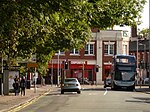The Hulme Hippodrome, a Grade II listed building, was originally known as the Grand Junction Theatre and Floral Hall and opened in Preston Street, Hulme, Manchester, on 7 October 1901. Preston Street is now a footpath, the road being removed in the 1960s. The Hippodrome and the smaller Playhouse Theatre in the same building (doors open onto Warwick Street), built at the same time, were part of the theatrical empire of W. H. Broadhead. The two venues were reportedly connected by an arcade (some researchers question this feature existed), and the extensive building was Broadhead's company headquarters. Various architectural drawings exist for the building, not all of which correspond with the eventual constructed form of the building. The architect was J.J. Alley. Initially the theatre staged mainly dramatic productions, while the Playhouse presented variety performances, but in 1905 the names and functions of the two adjacent theatres were interchanged: the Hippodrome became known as the Grand Junction, and the variety performances were transferred to the new Hippodrome.The Hippodrome was last used as a theatre in the 1960s; from the mid-1970s until its closure in 1988 it was used as a bingo hall. Since then most of the building has remained empty, and it has been placed on Manchester City Council's Buildings At Risk Register, and in 2006 was added to the Theatre Trust's newly-created Theatres At Risk Register.The building was bought by Gilbert Deya Ministries in 2003, and services were held in part of the ground floor in the area known as the Floral Hall. The church spent £200,000 on the building and in 2013 leased it to another charity, Youth Village, they then decided to sell the building.The Friends of Hulme Hippodrome group had hoped to get the building listed in 2016 as an asset of community value, which would have given the community group six months to raise the money needed to buy the building from the owner before it went out to general market. The application, however, was turned down by Manchester City Council. A council spokesman said: "There would also be a significant cost to bring the building back into use—into the millions—and without a [business] plan in place it would be unfair for us to assume they could turn the building around."The adjacent Playhouse Theatre, a portion of the entire building, was sold at auction on 18 May 2017 at the Macron Stadium, Bolton, for £325,000 - it was known as the Nia Centre and currently is tenanted by and known as Niamos, a community interest company (CIC). In autumn 2017, squatters occupied the building, intending to bring it back into community use. They reported cleaning it up after years of neglect, though other accounts differ. In September 2019, the building was named on the Victorian Society's list of the top ten most endangered buildings in England and Wales.In February, 2021, a campaign called Save Hulme Hippodrome was created by a group from the local area with the goal of bringing the hippodrome into community ownership with the hopes of restoring it and using it as a community centre and the campaign became a limited company in March 2021.








